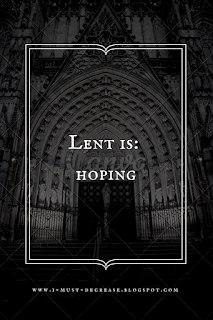Lent is: hoping.
How do you stay hopeful? a friend asked me this week.
The question caught me off guard at first, wondering if I truly was hoping through a rough week of pain and restlessness. So I was as honest as I could be with her:
It’s been hard. So hard. I think I’ve mostly tried to stay expectant that He’ll say something to me, anything to help me through. And last night, I put myself in a deliberate weak spot—in the car, traveling to go teach. I was feeling low, really non-hopeful, and was distant towards Him. I played worship music even when I couldn’t sing it, when my mouth was dry with anger over a fresh set of dashed expectations. But it was a space I knew He had to show up. And He did.
I think another way I stay hopeful is by allowing myself to feel the feelings for a minute that are dragging me down. Faking my way to hope won’t get me there at all. I have to feel the hopelessness, let the tears come, as I plead with Him to Himself come.
***
I fell asleep last night with these very words on my lips, a few wet tears at the corners of my eyes. I woke up to a three or four minutes of relief—feeling rested, with no pain. As the exhaustion (yes, of simply waking up) and pain fell back over me, I heard a whisper: This won’t last forever. And I truly believe that the Father was helping me, meeting me, and keeping me hoping in Him.
This is another facet of what Lent is: hoping even when all seems hopeless. Lent has always been regarded as a dark season, a season of desolation and denying ourselves little pleasures in life to understand the sufferings of Christ. In the car on Wednesday night this week, I let a few tears fall as I fogged up the window with words: I didn’t know that Lent would be like this. And the deeper self-inflicted jab: I should’ve known Lent would be like this.
I’ve been here before, in this place of physical pain colliding with spiritual realities. I’ve been told I’m not praying enough, I don’t have enough faith, I just need to trust God. But hoping doesn’t look like any of those things. Hope looks like tears escaping alongside the prayer, fear walking beside faith, trust mingling with fear. Hope is a paradox in the Biblical narrative: there’s always a reason not to have it. It’s always regarding something unseen, something crazily unlikely to happen, something that might disappoint us.
But in God’s kingdom, hope—in the future tense—will be seen, will happen, and will not disappoint us or put us to shame.
I have to let you in on my favorite words about hope, now:
“Hope” is the thing with feathers (314)
by Emily Dickinson
I love this poem so much, and have since the first day I read it. It captures the heart of hope so beautifully—this resilient, persistent, bird-like thing within us the exists utterly apart from us and yet finds a resting place within us to sing its song. That’s just like hope, unseen and hard to get to know—yet relentless in its pursuit of us.
That’s just like God.
If Lent is about hoping, then Lent is about God, not us. It’s about His pursuit of us, even as we walk the wild, calvary way, where hope is hard to find and even harder to hold. It’s about His grace, leading us to hope, even where we fall short of the goals and limits we try to place on ourselves. It’s about Him, hope-in-human-like-form, walking with us wherever we go.
So, I’m asking…what are you hoping for these days? As we continue wading into Lent, where is your hope set? On what you can accomplish in these days of self-denial and commitment? Or on what He can?




Comments
Post a Comment